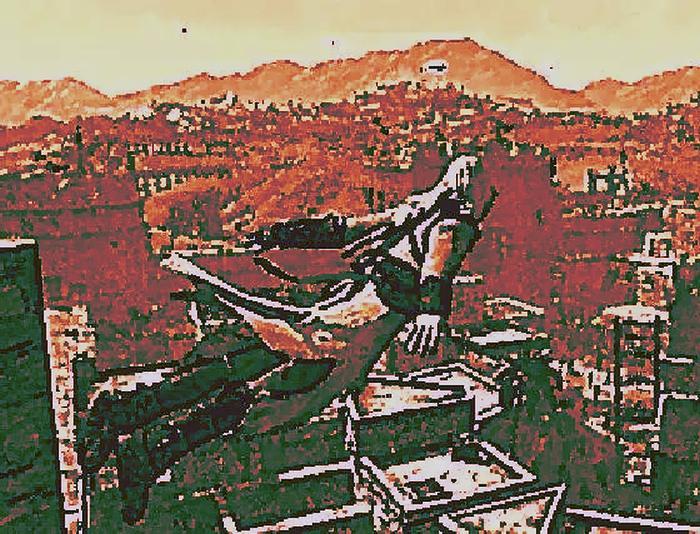The Holy Killers of Islam And Christianity : The Old Man of The Mountains
Last updated on December 27th, 2023 at 09:20 am
_χρόνος διαβασματός : [ 12 ] minutes
Nothing is true, everything is permissible.
Authored by Arkon Daraul via History of The Secret Societies

The Eagle’s Nest
Two men in the year 1092 stood on the ramparts of a medieval castle ,
the Eagle’s Nest, perched high upon the crags of the Persian Mountains: the personal representative of the Emperor and the veiled figure who claimed to be the incarnation of the God on earth.
Hassan, son of Sabah , Sheikh of the Mountains and leader of the Assassins , spoke:
“You see that devotee standing guard on yonder turret-top? Watch!”
He made a signal.
Instantly the white-robed figure threw up his hands in salutation, and cast himself two thousand feet into the foaming torrent which surrounded the fortress.
“I have seventy thousand men and women throughout Asia, each one of them ready to do my bidding .
Can your master, Malik Shah, say the same? And he asks me to surrender to his sovereignty! This is your answer…Go!”
Such a scene may be worthy of epic movies like Conan the Barbarian, but yet it took place in historical fact.
Hasan’s Contest

Sabah the man that came with his uncanny power and his men whom struck terror from the Caspian to Egypt .
Today , the sect of the Hashishin still exists in the forms of the Ishmaelites, whose undisputed chief, endowed by them with divine attributes, is the Aga Khan.
In the seventh century A.D., a significant division arose among the followers of Islam. This division separated into two distinct groups: the orthodox and the Shiahs. The orthodox believers held the belief that Prophet Mohammed was the bringer of divine inspiration, while the Shiahs, on the other hand, regarded Ali, Mohammed’s successor and the Fourth Imam, as being of greater importance.
Our focus here lies with the Shiahs. Right from the onset of the split, the Shiahs relied on secrecy as a means of ensuring their survival. Despite being the minority party in Islam, they firmly believed in their ability to overcome the majority and eventually conquer the entire world through superior organization and power.
To achieve their objectives, the Shiahs established various secretive societies. These societies engaged in secret rituals, venerating the personality of Ali. The members of these societies, from the lowest ranks to the highest, were trained to prioritize the pursuit of world dominion above all else.
It is within this historical context of the Shiahs’ clandestine practices and their aspirations for global dominance that we find our focus. Through their dedication and unwavering commitment, the Shiahs sought to shape the course of history and leave an indelible mark on the world.
Indeed, one of the most influential secret societies established by the Shiahs revolved around the Abode of Learning situated in Cairo. This institution served as a training ground for devoted individuals who were meticulously conditioned to embrace a specific divine mission. However, in order to achieve this objective, the original democratic Islamic ideals had to be overcome through the guidance of skilled teachers acting under the orders of the ruling Caliph of the Fatimites, who held authority over Egypt during that era.
Ismail, the Seventh Imam, occupied a position of immense reverence within this society. He was regarded as the embodiment of divinity, surpassing even the revered Tibetan lamas in his spiritual significance. The Abode of Learning itself resembled renowned educational institutions like Oxford in many ways, boasting a structured curriculum and fostering an environment of intellectual growth. However, its primary purpose and mission differed significantly from conventional universities.
The primary goal of these Shiahs’ universities was the complete transformation of the students’ minds. Through cunning methods and meticulous teachings, the students were subjected to a rigorous process of mental and ideological reshaping. The aim was to instill within them an unwavering belief in the divine mission they were destined to pursue. This process of indoctrination aimed to mold fanatics who would zealously dedicate themselves to the fulfillment of this sacred purpose.
Within the secretive confines of the Abode of Learning and other similar institutions, the Shiahs worked tirelessly to shape the minds of their disciples. These efforts were driven by a profound conviction that their divine mission was of paramount importance and that the transformation of the students’ minds was crucial to its success.
The initiation process consisted of nine degrees, each with its own significance and teachings. Here are the details of the first and seventh degrees:
The Doubt (First Degree)

In the first degree of initiation, the teachers aimed to instill doubt in the minds of the students regarding conventional ideas, both religious and political. The purpose was to challenge established beliefs and ideologies, creating a sense of skepticism. The mantra “Nothing is true, everything is permissible” encapsulates the mindset that emerged from this degree, encouraging individuals to question and explore alternative perspectives.
The Lord of the Time (Seventh Degree)

The seventh degree of initiation revealed the Great Secret to the students. This secret conveyed the notion that all of humanity and creation were interconnected, forming a unified whole. Every aspect of existence, including the creative and destructive forces, was seen as part of this interconnected web. As an Ismaili, the individual was believed to possess the potential to awaken and harness the hidden power within themselves. This power allowed them to transcend the limitations of those who were ignorant of the immense potential inherent in humanity. The aid of a mysterious power known as the Lord of the Time was said to facilitate the awakening and utilization of this hidden power.
1058 A.D.
During this year, the secret society achieved real success outside of its original location. It extended its influence to Baghdad, where a member of the society gained temporary control over the city. This individual even minted money in the name of the Egyptian Caliph. However, their control was short-lived, as they were slain by the Turks who entered the picture. Additionally, the Cairo headquarters of the society was also threatened.
1123 A.D.
By the year 1123, the society had been closed down by the Vizier Afdal. The rise of Turkish power seemed to have discouraged the expansionist ambitions of the Cairo sect of the society. As a result, they faded out and little is heard of them after this date. However, it was during this time that Hasan, the son of Sabah, known as the Old Man of the Mountains, emerged. Hasan went on to perfect the system of the secret society and establish an organization that would endure for nearly another thousand years.
Hasan Origins

Hasan, the son of a devout Shiah from Khorasan, was a man of strong convictions. He proudly claimed that his ancestors hailed from the Arab city of Kufa, a belief that enhanced his religious status among Muslims, as it does today. However, the people in his neighborhood, many of whom were also Shiahs, firmly asserted that Hasan’s true lineage was Persian, including his forebears. This version is widely accepted as the accurate one.
Since the Governor of the Province adhered to orthodox Islamic beliefs, Hasan went to great lengths to conform to the same orthodox appearance. Such an act was deemed completely permissible, following the Doctrine of Intelligent Dissimulation. To dispel any doubts about his religious commitment, Hasan withdrew into seclusion, adopting a monastic retreat. Meanwhile, he enrolled his son, Hasan, in a conventional school.
This school was rather ordinary, but it was there that Hasan encountered two notable individuals: Omar Khayyam, the renowned tentmaker-poet and astronomer, who would later become the poet laureate of Persia, and Nizam-ul-Mulk, an individual who ascended from peasant status to becoming the prime minister. The three of them forged a pact, as described in Nizam’s autobiography, vowing to support one another when they achieved positions of power.
After Nizam became the vizier to the Turkish sultan of Persia, Alp-arslan, Hasan embarked on a journey across the Middle East, remaining in obscurity, patiently awaiting his chance to seize the power he had long desired. Eventually, Alp-arslan, the Lion, passed away, and Malik Shah succeeded him.
Dissimulation Master

In a sudden turn of events, Hasan boldly presented himself before Nizam, demanding a place at the royal court. Eager to fulfill the vow they made in their youth, Nizam, the vizier, used his influence to secure a prominent position for Hasan. However, little did Nizam know that he had unwittingly welcomed a fraud, a hypocrite, and a self-seeking villain into the heart of the kingdom.
Hasan possessed an exceptional talent for dissimulation, effortlessly masquerading as a pious and righteous individual when, in reality, he lacked such virtues. Through his calculated actions, he managed to captivate the mind of the young Shah, Malik Shah, who was still in the early stages of his reign. Hasan, trained in the art of winning people over through apparent honesty, utilized his skills to sway the impressionable ruler.
However, Nizam, with his impressive track record of honesty and accomplishments, remained the most influential figure in the realm. This fact did not escape Hasan’s attention. Consumed by ambition and the desire for absolute power, Hasan devised a sinister plan to eliminate Nizam, thereby removing the only obstacle standing between him and complete control.
With deceit and treachery as his weapons, Hasan set his intricate scheme into motion. He meticulously crafted a web of intrigue, weaving lies and manipulating events in order to undermine Nizam’s credibility and influence. Hasan’s ultimate goal was to eradicate anyone who posed a threat to his ascent to power, and Nizam, with his unwavering integrity and the support he commanded, was at the top of his list.
As the story unfolds, the fate of Nizam and the kingdom hangs in the balance, with Hasan’s true nature gradually unraveled as he navigates the treacherous path towards his sinister ambitions.
Rule under Deception

We then learn about a task given to Hasan by the King to complete the accounting of the empire’s revenue and expenditure. Nizam, however, had informed the King that this task would take over a year to complete. Hasan, on the other hand, claimed that he could finish the work in just forty days and offered to prove it. The King assigned the task to Hasan based on his confident assertion.
However, something went awry during the process, leading to Nizam’s retaliation at the last moment. Nizam, torn between his connection to Hasan as childhood playmates and the potential danger he posed, decided that Hasan needed to be neutralized. He realized that Hasan had the potential to bring harm to them all, but he couldn’t bring himself to kill his former companion.
The exact details of what went wrong during the task remain uncertain. However, it is believed that Nizam managed to introduce deliberate disparities into the final calligraphic version of the accounts. When Hasan began reading them, the discrepancies appeared so absurd that the Shah, in a fit of fury, ordered Hasan’s exile. Hasan, who had claimed to have written the accounts in his own hand, was unable to justify the incredible deficiencies that were present.
As a result, Hasan’s credibility was shattered, and he was banished from the kingdom. This turn of events revealed the depths of Hasan’s fraudulence and cunning nature, as well as Nizam’s resourcefulness in countering his machinations.
Hasan’s Exile and Vow for Revenge

Following his banishment, Hasan sought refuge in Isfahan, where he had a circle of friends. During his time there, an account was recorded that sheds light on his state of mind. One of his friends, Abu-al-Fazal, documented an incident where Hasan, consumed by bitter emotions, expressed his burning desire for retribution.
In a fit of uncontrollable rage, Hasan exclaimed, “If I could find just two loyal supporters who would stand by me, I would orchestrate the downfall of that Turk and that peasant.” These words revealed the depth of Hasan’s anger and his determination to seek vengeance against those he felt had caused his downfall.
Abu-al-Fazal, concerned about Hasan’s mental well-being, interpreted his outburst as a sign of a troubled mind. He attempted to console Hasan and persuade him to let go of his vengeful thoughts. However, Hasan took offense at Fazal’s intervention, refusing to be pacified. He insisted that he was actively formulating a plan and vowed to achieve his revenge.
He embarked on a journey to Egypt, intending to develop and refine his strategies. Fate would bring about an unexpected turn of events. Years later, in a conversation with Fazal, who had become a devoted follower of the Assassin chief, Hasan reminisced about their encounter in Isfahan.


At Alamut, Hasan proclaimed, “Behold, I stand here as the Master, gazing upon all that lies before me, and more. The Sultan and the lowly peasant Vizier have met their demise. Did I not fulfill my vow? Was I the madman you once believed me to be? I found my two loyal devotees, whose presence was pivotal in the realization of my grand plans.”
This revised document reflects Hasan’s journey to Egypt, his encounter with Fazal, and his triumphant return to Alamut as the mastermind behind his accomplished ambitions. However, it is important to note that this text is fictional and constructed based on your instructions.
Plan of Reckoning

Hasan himself recounts the story of his fate following his departure from Persia. Having been raised in the secretive teachings of Ismailism, he recognized the immense potential for power inherent in such a doctrine. Aware of the influential presence of the society in Cairo, he devised a plan, as conveyed by Fazal, to transform their followers into devoted and disciplined fanatics, willing to sacrifice their lives for a leader.
What was this plan? Hasan concluded that merely promising paradise, fulfillment, and eternal joy to people was insufficient. He intended to go beyond mere words and demonstrate it to them tangibly. He envisioned an artificial paradise, where houris frolicked and fountains overflowed with sweet-scented waters. In this paradise, every sensual desire would be fulfilled amidst breathtaking flowers and opulent pavilions. And eventually, he brought this vision to life.
This revised version portrays Hasan’s understanding of the potential power within Ismailism and his strategic plan to create a devoted following. His decision to manifest an artificial paradise, where sensual desires were indulged, showcases his calculated approach to captivate and control his followers. However, it is important to note that this text is a fictional narrative based on your instructions.

Paradise
Hasan carefully selected a concealed valley as the location for his envisioned paradise, a place described by the renowned explorer Marco Polo, who traversed this region in 1271.
Additionally, Hasan employed various theatrical illusions, such as a deep and narrow pit concealed beneath the floor of his audience chamber, to enhance the impact and fervor associated with martyrdom. By employing such techniques, he successfully cultivated an atmosphere that intensified the devotion and commitment of his followers to the desired level.
Consequently, Hasan managed to create truly dedicated disciples (known as fidayis) throughout his dominion.
Birth of Alamut

In the year 1090 AD, Hasan’s trusted lieutenant, Hussein Kahini, conveyed a significant finding. He reported that the Iraki district, where the formidable fortress of Alamut stood, appeared to possess the ideal conditions for spreading their beliefs. This revelation served as a crucial development for Hasan’s grand plan.
With this information in hand, Hasan embarked on the next phase of his strategy. He orchestrated a series of calculated attacks, employing his skilled assassins as instruments of his vengeance. The first targets of his deadly campaign were the Vizier Nizam-ul-Mulk, who met his demise through a fatal stabbing to the heart, and Emperor Malik Shah, who fell prey to a carefully administered poison.

By selecting his former classmate as the initial victim of his reign of terror, Hasan sought to exact his revenge upon an individual whom he once shared a common bond. These actions underscore the calculated and ruthless nature of Hasan’s plan.
The Sheikh of the Mountain

Following the demise of the King, the realm was thrown into chaos, as warring factions emerged, vying for power and control. Amidst this turmoil, the Assassins stood apart, maintaining their unity and cohesion. In a remarkably short span of under a decade, they swiftly asserted their dominance over Persian Irak and secured numerous forts throughout the empire.
The loyalty of the Ismaelis, who were under the influence of the Sheikh of the Mountain, shifted entirely from the Caliph to their enigmatic leader. This transformation instilled fear in every prince across the region, including the leaders of the Crusaders. The Sheikh of the Mountain became a dreaded figure, striking terror into the hearts of those who opposed him.
Undeterred by fatigue, danger, or torture, the Assassins willingly sacrificed their lives at the behest of their great master. Clad in white tunics adorned with red sashes, symbolizing innocence and blood, they fearlessly embarked on their missions, regardless of the distance or peril. When they located their target, they patiently awaited the opportune moment to strike, with their daggers rarely failing to find their mark.
A Tale from Two Kingdoms

In historical accounts, there is an accusation that Richard the Lionheart, renowned for his military prowess, was implicated in a plot to eliminate Conrad of Montferrat. It is alleged that Richard sought the assistance of the infamous ‘Lord of the Mountain’ in carrying out this clandestine operation.
The plot unfolded in a cunning manner. Two assassins, disguised as devout individuals, went so far as to undergo baptism, thereby gaining the trust of those around them. They positioned themselves beside Conrad, seemingly engrossed in prayer, concealing their true intentions. However, when the opportune moment presented itself, they swiftly struck, stabbing Conrad with deadly precision. One of the assassins sought refuge within the sanctuary of a church.
Upon learning that Conrad had not succumbed to his injuries and had been whisked away while still alive, the assassin, undeterred, made a determined effort to reach Conrad’s side once more. In a final act of desperation, he delivered a second fatal blow, sealing Conrad’s fate. The assassin, having fulfilled his mission, breathed his last breath without uttering a single complaint, enduring the agony of refined tortures.
Military Force In Secrecy

The Order of the Assassins possessed an unparalleled ability to secure the unwavering loyalty of individuals, a feat that was rarely matched in scale and effectiveness. They strategically waged their battle on two fronts, aligning themselves with whichever side in the Crusades best served their interests, while simultaneously continuing their struggle against the Persians.
During the reign of Nizam-ul-Mulk’s son and successor, the Assassins employed their trademark method, using a dagger to eliminate their targets. In this case, the Sultan, who had inherited power over a substantial portion of his father Malik Shah’s territories, was targeted. One fateful morning, he woke to find an Assassin’s weapon planted meticulously in the ground near his head, accompanied by a note. The message warned him to abandon his plans to besiege Alamut, the stronghold of the Assassins.
Despite his position as a formidable ruler, the Sultan opted to negotiate with the Assassins rather than face their deadly wrath. In exchange for a pact, which included a commitment to reduce their military power, the Assassins were granted a significant degree of autonomy. This agreement effectively granted them a free hand in their activities.
The End ?
Hasan, the founder of the Order of the Assassins, lived for thirty-four years after acquiring Alamut, the castle that would become the stronghold of the Assassins. Despite rarely leaving his room during this period, Hasan wielded immense power and ruled over an invisible empire that was both formidable and feared.
Hasan’s astute awareness of his mortality led him to meticulously plan for the perpetual continuation of the Order of the Assassins. He recognized the importance of ensuring the organization’s survival and influence even beyond his own lifetime. By developing comprehensive strategies and mechanisms, Hasan aimed to establish a lasting legacy that would transcend his imminent demise.
The Order of the Assassins, under Hasan’s leadership, had become renowned for its stealthy and deadly methods. Operating in secrecy, they carried out covert assassinations, strategically eliminating their targets to advance their own interests. This clandestine approach allowed them to exert significant influence over the political landscape of the time.
In his final years, Hasan’s focus shifted towards securing the future of the Order. He laid the groundwork for the organization’s continued existence, devising plans and structures that would enable it to thrive even in the absence of his direct guidance. Hasan’s vision and preparations ensured that the Order of the Assassins would remain a force to be reckoned with, shaping the course of history for years to come.
–
“Do Not Question The Nature of One’s Own Reality It’s A Sin Against God”
If you are interested in any of the issues raised in this article, please call the Samaritans for free on +44 116123 or visit their division at: https://www.samaritans.org
If you liked the post and want contribute to its cause leave us a contribution, anonymity guaranteed thanks to Monero :





